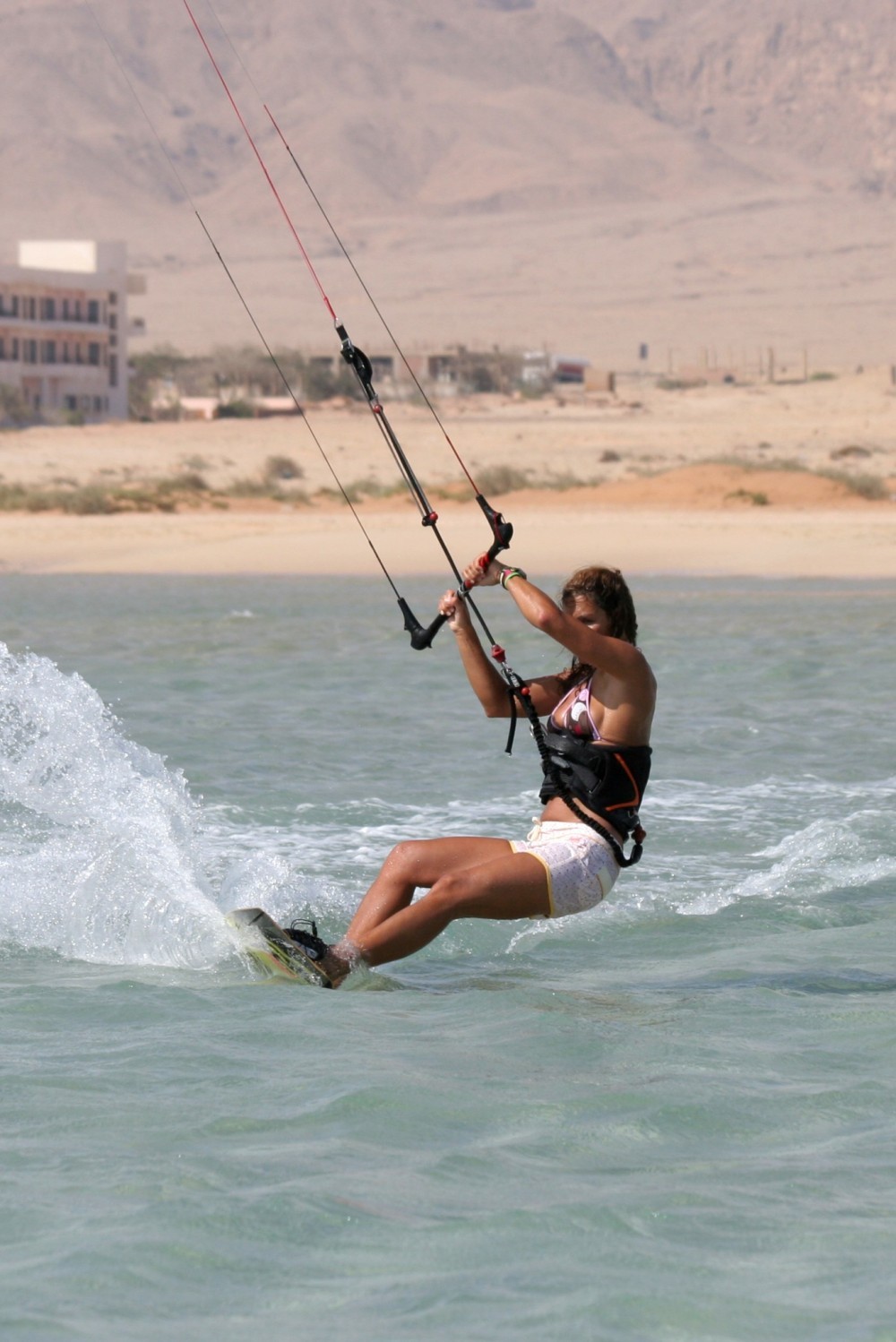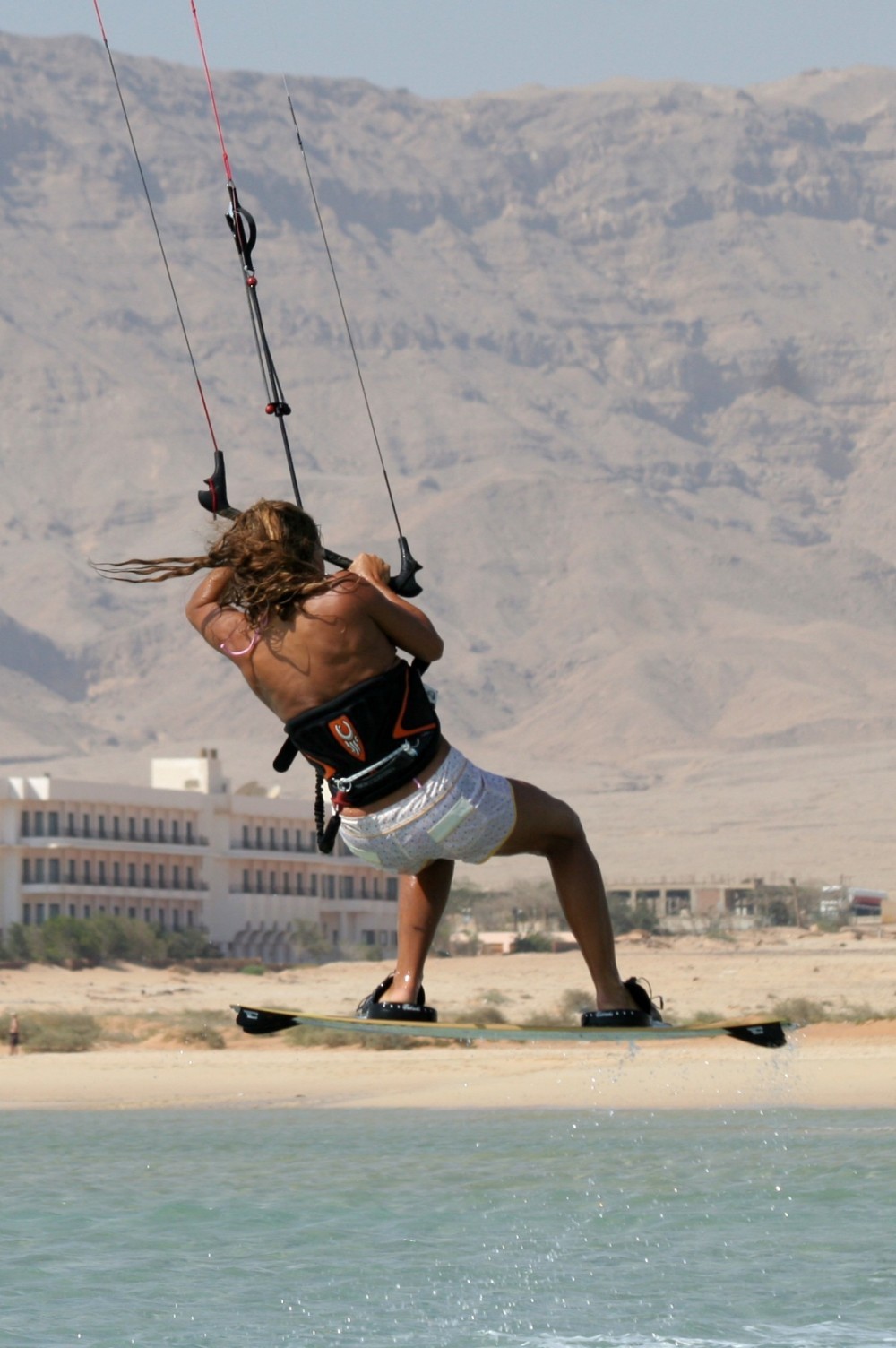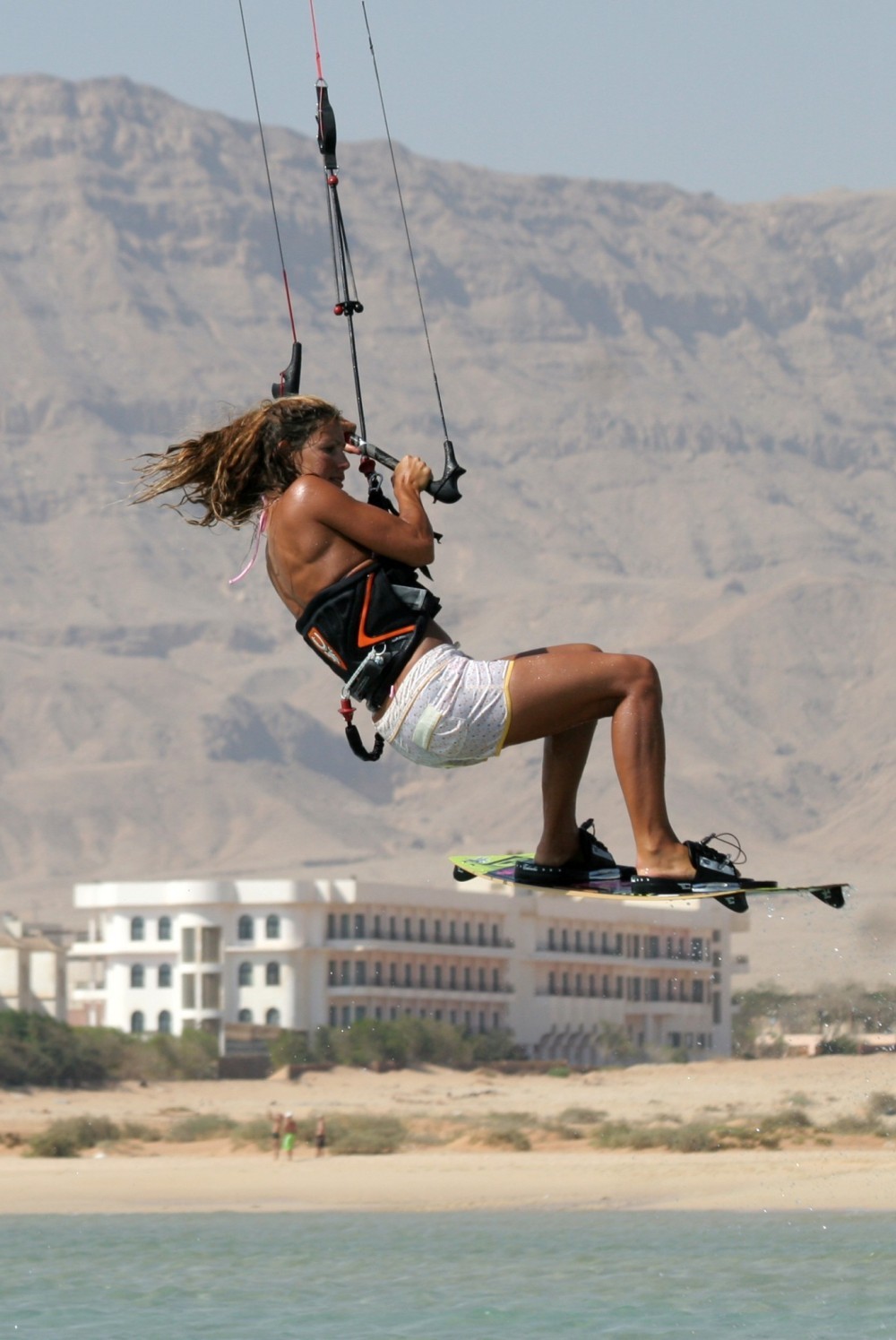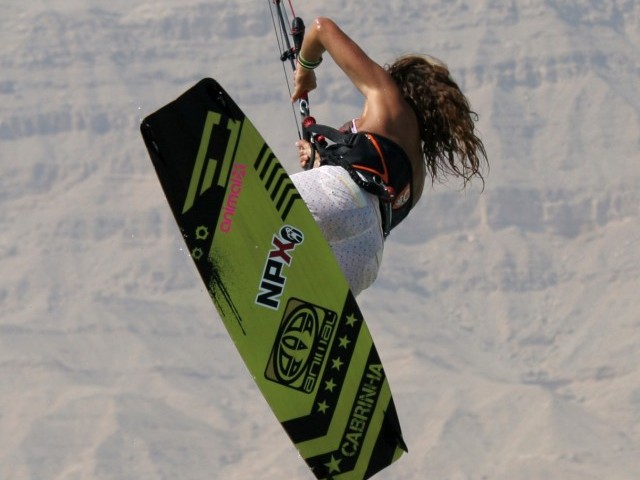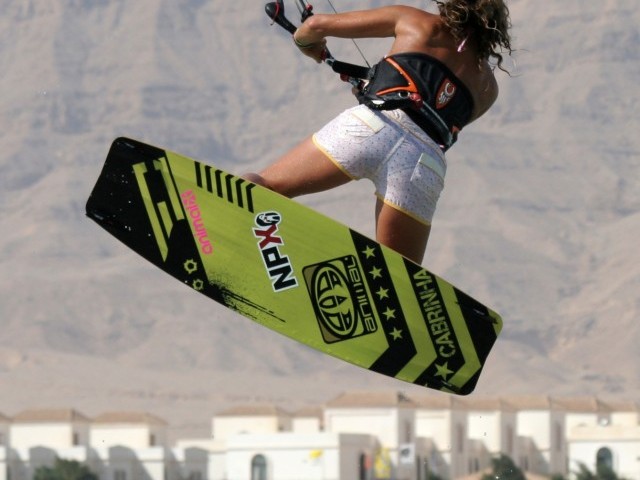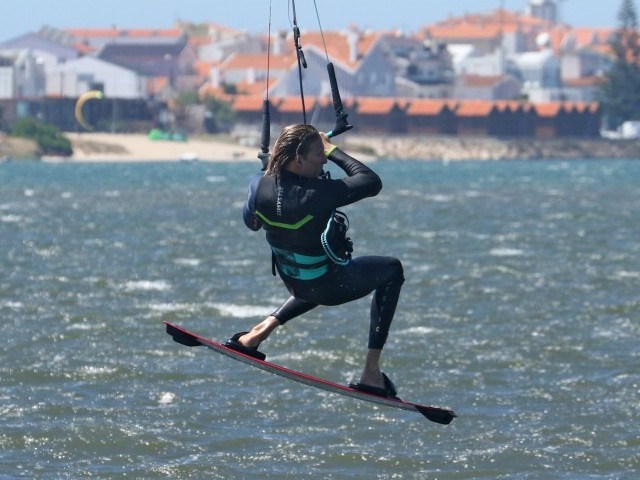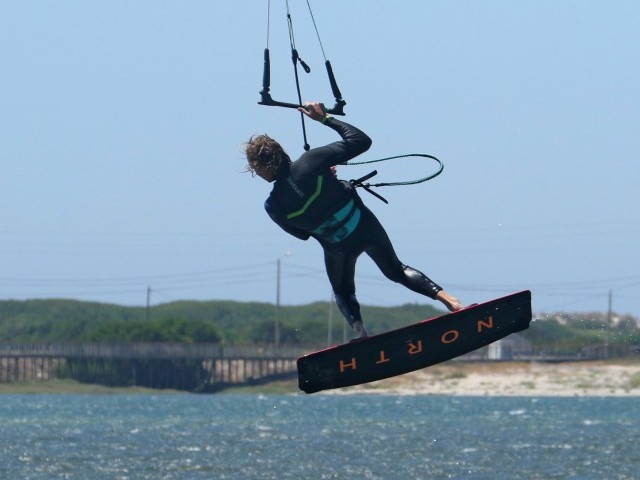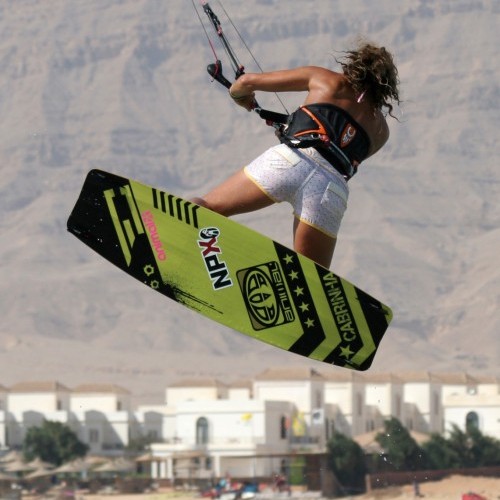
Front Loop Kiteloop
Technique / Intermediate
Introduction
This is a stunning move for those that like ballsy tricks where it’s all about setting everything up correctly, then holding onto your eyeballs as the kite does the rest as Karine does in Video 1. For sure there is more to it than that, but this trick is all about commitment, once you’ve set the wheel in motion you’re a whole lot better off going the full nine yards than trying to jessy out. The good news, however, is that you can build up into this trick, and therefore save yourself any unnecessary spankings.
Your Armoury
To give yourself a good chance of nailing the front loop kiteloop there are definitely a handful of things that you should be able to do. Due to the fact that you will be looping forwards whilst the kite loops backwards, you will perform this move blind, as all the action will be happening behind you. The base for learning this move is a front loop transition, so this needs to be solid. On top of that this should not be the first kiteloop you’re attempting, as you really need to have your fast and sometimes hard landings down.
First Steps
To get your head around the idea of what’s going on we’ll start at the front loop transition. Normally as you exit the transition you should be diving the kite hard. This pulls you out of your rotation and encourages you to land downwind. Essentially this results in the kite diving straight down through the window, and it usually takes a fair old tug to stop the kite hitting the water. It is then you carving back onto your edge and the kite rising which takes you back in the other direction.
Once you done a few front loop transitions and feel comfortable with the approach and loop its time to move on. Now as you exit the move, just as your board touches down pointing off the wind, rather than pulling the kite back up, pull harder with your back hand so that the kite loops under itself. This way if you follow the pull of the kite you will carve out in the same direction that you went into the move, so no change in direction. What you will have done is a floaty front loop, with an exceedingly late on water kite loop. Make sense?
Stepping it up a Gear
Before going through the move and encouraging you to simply “go earlier” and “pull for your life” lets have a look at some of the crucial stages. This way you’ll hopefully be able to see which parts you need to work on.
The Approach - Pic A
Karine just before take off. If you look at her hands and the bar you can see that she has sent the kite back, but not as aggressively as she would for a jump. There are two reasons for this. Firstly you don’t want to be jumping as high as possible. As this move is all about commitment, make it easier to commit. Once you’re three metres up you may well find the thought of looping your kite less appealing. Secondly you don’t want your kite to go too far behind you. The further back it goes, the lower it will loop, which in turn means a heavier landing. Apart from the gentler sending, much as a transition, Karine is still carving hard against the kite off her back foot and dropping her weight against the upward pull of the kite.
Timing - Pic B
Karine is most definitely rotating into a front loop. You can see how her front shoulder is still dipped down from the take off and that she has already brought her legs up for balance and speed of rotation. However the really exciting part of this picture is the bar. Her back hand has slid all the way to the end of the bar, so she can get some decent purchase to crank the bar in and get the kite turning into its loop. It’s also worth noting that Karine has not pulled her front hand in. It’s very easy to pull hard on the back hand and subconsciously pull down on the front hand too. Just keep the bar sheeted in with the front hand and let the back hand/arm do all the work. When learning this the harder you pull on the bar and the quicker the kite turns the gentler the kiteloop will be. From here there is no way back.
Kite Control - Pic C
Says it all. To be in control of the kite and to make sure it loops you need to have tension on the lines. Here you can see that Karine has the bar sheeted in, so the kite will react. Also by making a physical effort to keep the bar sheeted in you are far less likely to let the bar slide out as the power comes on, which would unfortunately stop the kite from turning. An added bonus is that as the looping kite pulls you will feel it through your arms, not just your harness and thus you’ll be able to keep your balance more easily.
Commitment - In Pic D
Karine has been pulled around her front loop by the looping kite pulling her harness hook. As long as the kite loops you will always finish your rotation. Even though she’s around if you look closely she still has the bar pulled right in, with both hands on the bar and is still giving it plenty with her back hand. It is tempting to ease off because it will feel like the kite has turned further than it really has, but if you do, at best you’ll end up splashing down in what looks like a dodgy transition. Karine is also looking where she wants to go, so her body will follow and she’ll end up in the right place and balanced for the landing. As a reference try to look ever so slightly behind of down wind, this way you can land with speed and then carve out, and if you have looped the kite too fast you can carve back from where you came having turned the whole thing into a front loop kiteloop transition!
So now that you hopefully have a clear idea of what’s going on you can try and add a little bit of extra height by sending the kite with a tad more speed, and commit to pulling as soon as you feel yourself rotating. Have a look at the slow mo Video 2 to help you visualise.
Following Sequence 1
- Pic 1. Approaching with speed Karine has had a good check to see that she has ample room to get pulled back and downwind by a looping kite without risking anybody else’s sunny afternoon. She’s got a bit of water under her too. She sends the kite back positively, keeping the bar on the sweet spot.
- Pics 2 & 3. As per a front loop, Karine throws herself forward and down as the kite lifts her up off the water. At this point she levels the bar and sheets it in.
- Pic 4. As she starts to rotate Karine slides her back hand down the bar (if you find this too much, move your hand before you go into the jump), pulls her knees up and then pulls like mad on her back hand to get the kite looping.
- Pics 5,6 & 7. To increase her chances of success Karine keeps pulling on her back hand to make sure that the kite turns all the way and also keeps the bar pulled in, so that there is tension on the lines and the kite does what she expects/hopes.
- Pic 8. So far all through the rotation Karine has been looking over her back shoulder. As she gets most the way around the loop she can now see where she will land, so she focuses on that. This is no time for a cheeky peak to see where the kite is.
- Pic 9. With the kite powering around its loop, it spins Karine around so that her harness hook is pointing at where the pull is coming from, slightly behind of down wind. Karine keeps the bar sheeted in and keeps turning the kite with her back hand.
- Pic 10. This is the moment of most power as the kite starts to climb back up. Karine keeps her knees tucked up and pulls the bar with her hands to keep balance.
- Pic 11. Karine has survived the loop and just needs to stick the landing. With the power from the kite decreasing she starts to drop. This is her cue to let her feet drop beneath her.
- Pic 12. As her feet drop Karine aims for a downwind landing, concentrating on keeping her weight over the board, and not to one side or the other.
- Pic 13. Karine lands tail first but onto a level board, so she can soak up the speed. Once steady she carves back onto her edge, sighs with great relief and kites on smiling at the applause.
Common Problems
If you find that you finish your rotation and the kite is still pulling like mad, forcing you into a Mach 10 landing, which more often than not results with you going out the front door. This is definitely a case of you stopping pulling with the back hand. Easily done as the pull comes on strong, but you must really pull that hand through your hip throughout the move.
If you have a similar experience as above but the kite is crashing into the drink. Keep the bar pulled in all through the move, because if it creeps out, even if you are tugging on the back hand, it just won’t turn.
If you find yourself coming in to land with your board facing across the wind. Two possibilities here. Firstly if you are trying to land this move on your weaker side, chances are that you body is in self preservation mode and therefore is trying to twist around to its stronger landing foot, for a downwind toeside reception. Secondly if you are taking you front hand off for balance as you drop down, the pull transfers to your back hand and hip, which pulls them forwards and around, turning your board further across the wind. This will however help if you are planning to land toeside.
Keystones
- Keep bar in to sweet spot on take off.
- Move back hand down Bar.
- Start kiteloop as soon as you feel you are rotating under the kite.
- Keep both hands on the bar and keep the bar in.
- Look to land down wind over the board.
This technique article was in Issue 19 of IKSURFMAG.
Related
By Christian and Karine
Christian and Karine have been working together as a coaching team, running improver to advanced kitesurfing clinics since 2003.





